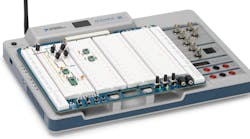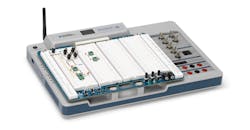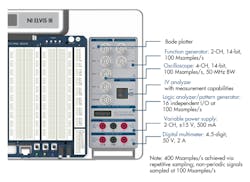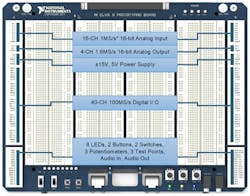How I would have loved to have National Instruments’ (NI) ELVIS III (Fig. 1) all-in-one electronics lab when I was a freshman studying to be an electrical engineer. The closest thing we had at the time was a patch board with RCA jack patch cables that plugged into a small refrigerator-sized box that was the front end for a couple dozen MSI TTL chips. Oscilloscopes were separate and a little smaller.
1. The ELVIS III all-in-one electronics lab developed by NI is essentially a CompactRIO, oscilloscope, logic analyzer, and DMM in a desktop package.
The ELVIS III Engineering Laboratory Virtual Instrumentation Suite (ELVIS) targets colleges, but it can be very useful in any lab that will be doing prototype work. The rugged base hides the guts of a CompactRIO that runs NI’s LabVIEW graphical programming environment. CompactRIO is essentially a PC with an FPGA optimized for control, test, and measurement chores. The complexity is hidden by LabVIEW.
One side of the ELVIS III (Fig. 2) exposes the connections for a function generator, four-channel oscilloscope, IV analyzer, logic analyzer, pattern generator, variable power supply, and digital multimeter (DMM). These are accessible to LabVIEW applications, but they’re usually used in conjunction with web-based apps. A typical environment would have a student with a tablet or laptop viewing the oscilloscope or logic analyzer apps. Yes, ELVIS III has USB, Wi-Fi, and Ethernet interfaces, so its only display is a tiny one that provides information like the unit’s ID.
2. ELVIS III includes a function generator, four-channel oscilloscope, IV analyzer, logic analyzer, pattern generator, variable power supply, and DMM that are linked to web-based apps.
The patch board (Fig. 3) that dominates the system is removable. Like the base unit, the board has its own unique ID. Therefore, a board can be matched to a student or group making connections to their smartphone, tablet, or PC automatic. The networked orientation makes it easy to control and monitor from multiple computers. This is useful for teacher-student interaction in addition to remote collaboration.
3. The all-in-one lab comes with a removable patch board that can be replaced with other devices and systems, such as a motor-control platform.
The patch board is only one of many options available for the ELVIS III socket. Plenty more are shown at https://learn.ni.com/teach, such as a Control System Design and Analysis platform that works with MathWorks’ Simulink. Boards address every electronic and mechanical aspect from power electronics to communication. Most are available from third parties as is much of the educational content.
NI is well-known in the educational community and part of the reason is its attention to integration details. In fact, ELVIS III has a web-based learning and teaching infrastructure built around it that’s probably more impressive than the hardware. Most is freely available.
Check back on our site for an upcoming hands-on review article that examines the ELVIS III in more detail. Pricing starts at $2799. It probably can be found in a college lab near you.





